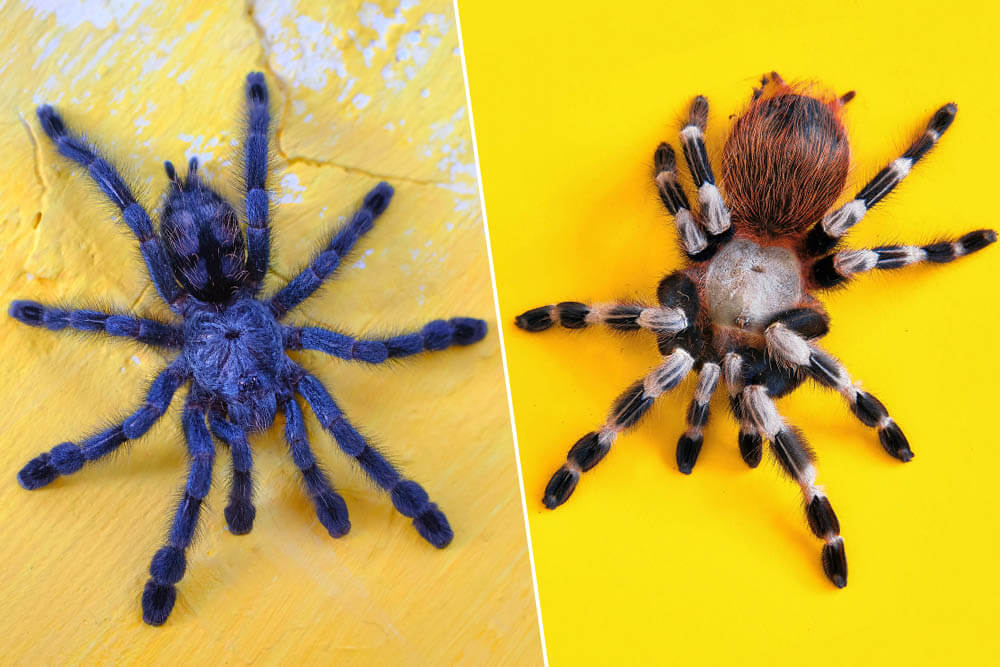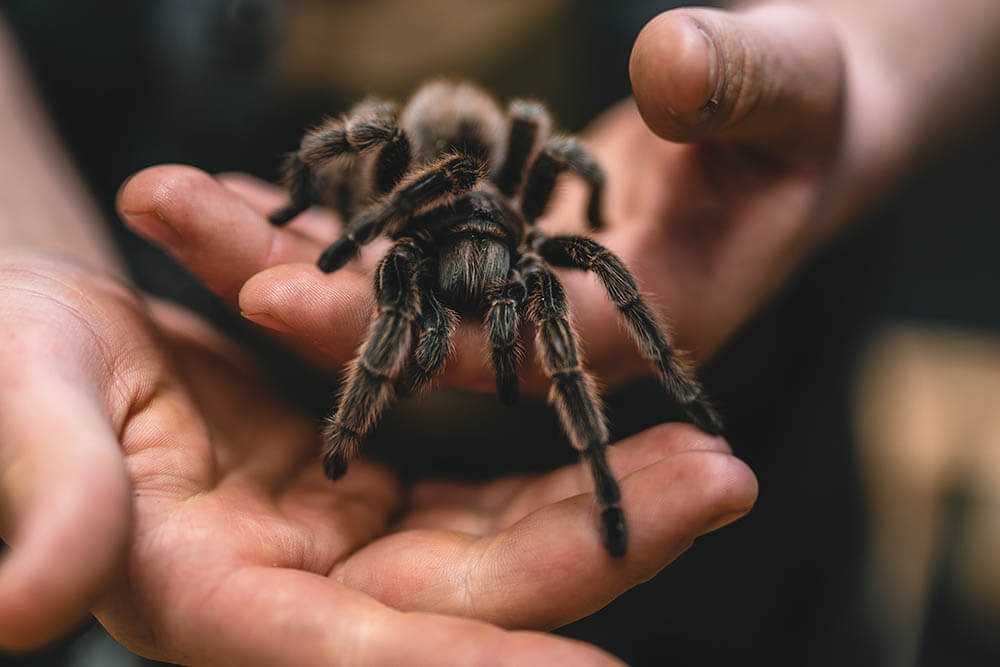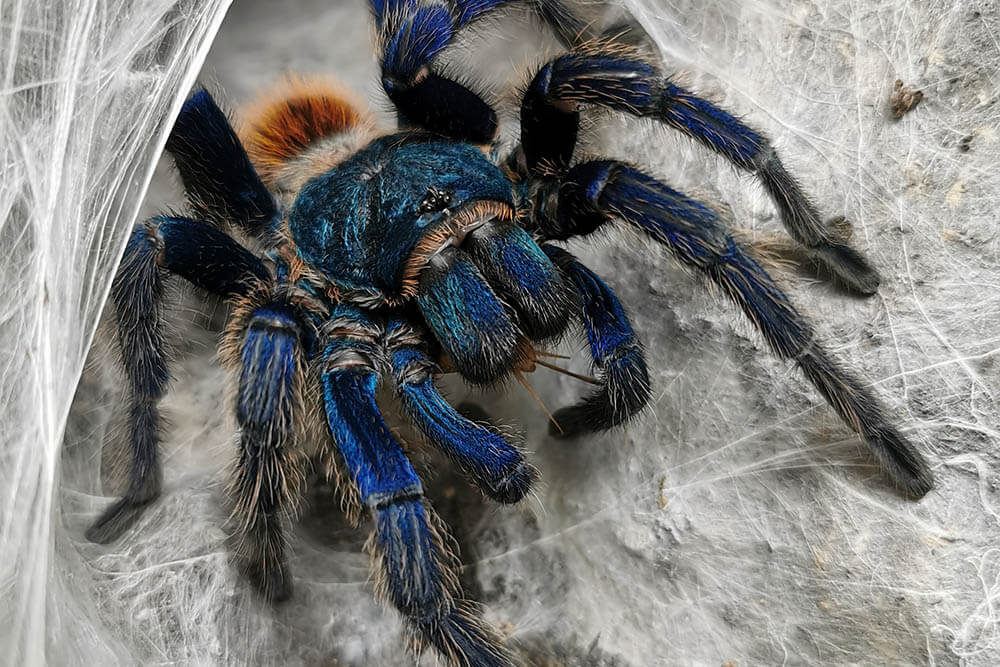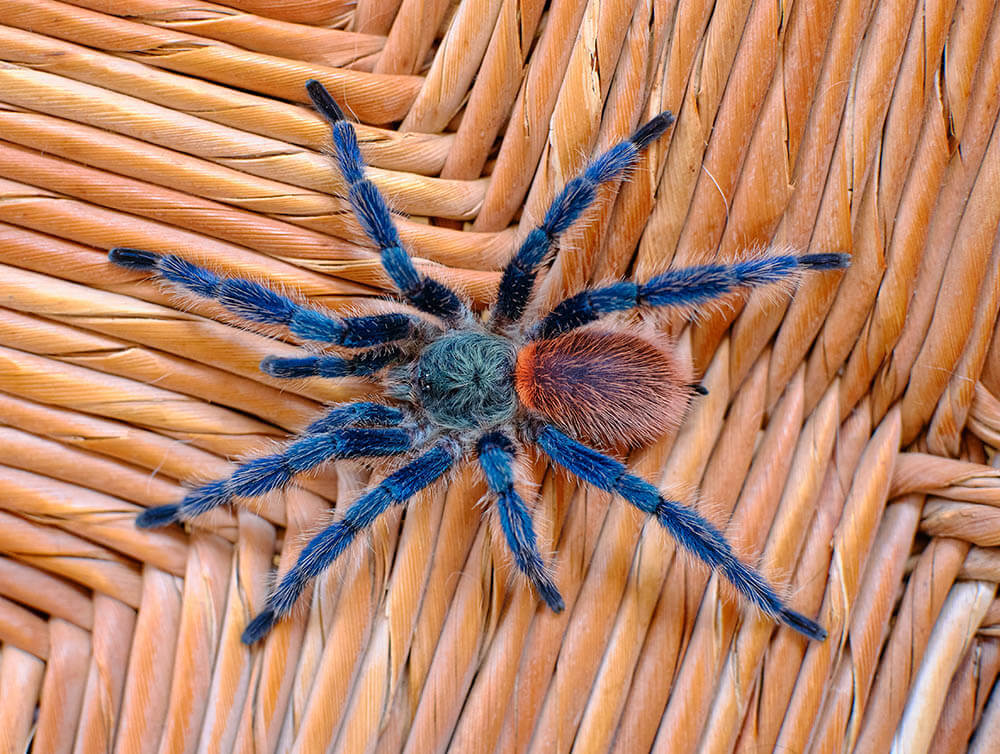Do tarantulas make interesting pets? Sure they do. They’re beautiful despite being intimidating, and there are few things cooler than having a pet that no one else would even dream of owning.
The more important question is: do tarantulas make good pets?
The quick answer is yes… as long as you prepare yourself for the challenges of tarantula ownership.

6 Reasons Why Tarantulas Make Good Pets
Tarantulas can make excellent pets for various reasons, including:
1. They’re low maintenance
Tarantulas are extremely easy to care for; you won’t have to walk them daily like a dog or worry about them clawing your furniture to shreds like a cat would. You don’t need to groom them, play with them, buy them toys, or cuddle with them.
You’ll need to feed your pet arachnid only once a week. Some species can even fast for up to two months. In addition, they typically need water once a month.
As tarantulas have environmental requirements, you’ll also need to ensure your pet is exposed to the ideal temperature, humidity, and light levels. Fortunately, this isn’t difficult to do.
You can maintain the temperature of your pet’s habitat by placing heating pads around its enclosure’s corners. Misting this habitat guarantees the tarantula enjoys the appropriate humidity levels. As for light, keep the enclosure somewhere dark; always avoid exposing your arachnid to direct sunlight, which can be harmful to these creatures.
2. They’re small and take up minimal space
Tarantulas may be enormous spiders, but they’re tiny compared to common pets such as dogs, cats, and pigs.
Depending on your pet’s species, it may grow to around 5 to 8 inches in size. This means it won’t steal your spot on the couch or topple things over whenever it hops onto a table or runs across a room. The tarantula’s small size also makes it easier to handle.
As for tarantula enclosures, they’re usually affordable and don’t take up much space, being generally a foot long. Therefore, expect to have an easy time maintaining your pet’s habitat.
In short, you only need to reserve a tiny space in your home for your eight-legged bestie.
3. They’re long-lived
Tarantulas have a long lifespan especially for a bug, with many species capable of living up to 20 years. That’s many years longer than most dogs and some cats!
If you want a pet that’ll be by your side for many years, it’s best to pick a female tarantula, as they have a life expectancy of between 20 and 25 years. In contrast, males tend to live a bit more than a few years.
4. They’re quiet and unobtrusive
Tarantulas are silent creatures. They don’t bark or howl, meow or hiss, or squeak or chitter. They don’t need noisy toys or equipment such as squeaky chew toys or exercise wheels. And being tiny, light animals, they don’t make much noise when they move around.
In addition, tarantulas aren’t stinky; unlike ordinary pets, they won’t make your house smell like an open sewer.
For these reasons, you won’t have to worry about your pet arachnid disturbing the peace at home or annoying your neighbors.
5. They’re solitary
Many common house pets are social creatures. Dogs, for example, are pack animals who need companions to stay happy and healthy; without humans or fellow canines to keep them company at home, they may grow lonely and bored, which in turn can encourage destructive and/or potentially dangerous behaviors.
Tarantulas, on the other hand, are loners. They do extremely well on their own, which means you don’t need to spend time with your pet to prevent issues like loneliness. You don’t even have to get another tarantula to accompany it, so you can keep your pet maintenance costs low.
6. They’re fun to observe
One of the best things about tarantulas is that they’re so bizarre. It’s not every day you see an eight-legged freak the size of a hand – unless you own a pet tarantula, of course!
Tarantulas do things that ordinary pets can’t. They burrow under the soil, molt, preen, flip over on their back, spin webs to protect their burrows, climb vertical walls, renovate their enclosures, and go on hunger strikes. They also consume things just as weird as they are, including crickets, mealworms, and hornworms.

6 Challenges of Keeping a Pet Tarantula
While taking care of a tarantula is easy, there are a few things you should keep in mind to ensure you or your pet comes to no harm.
1. They’re delicate
Thanks to their size, tarantulas aren’t the most robust of pets, which means rough handling can end up hurting them.
Tarantulas are even delicate enough that they can get seriously injured or perish from a fall. Remember this before getting your eight-legged pet an enclosure with a high roof.
Recall what we said about tarantulas requiring the right humidity levels to stay healthy? In an environment with low humidity, your pet could become dehydrated, in turn resulting in lethargy and possibly other health issues.
You should also make efforts to feed your pet properly especially when they’re growing or molting. Too much food during the molting phase can kill them. Too little food can lead to health problems and impede natural growth.
2. They won’t recognize you
While spiders have a good memory, a tarantula can’t recall its keeper’s face. This means your pet won’t remember who you are and may even perceive you as a threat, which could get you bitten if it doesn’t want to be handled or if you handle it roughly.
Their inability to recognize their keepers is one other reason why it’s best to avoid touching your pet tarantula as much as possible.
3. It’s not a good idea to handle them
As stated above, tarantulas can’t recognize their human owners, so your pet can mistake you for a predator. And when that happens, it could bite you when you pick it up or try to touch it.
Sure, most tarantula bites aren’t poisonous. But they can still hurt and cause concerns such as irritation, swelling, or itching.
In addition, tarantulas have thin abdominal hairs capable of causing skin irritation. Worse, if they enter your eyes, they can cause serious eye-related issues such as swelling. It’s for this reason you should avoid rubbing your eyes after handling a tarantula; always wash your hands thoroughly after touching your hairy friend.
4. Some species are venomous
Some tarantula species have a venomous bite; you’ll have no choice but to avoid touching such creatures at all costs.
The deadliness of a tarantula bite depends on the species. Some have mildly toxic venom that may cause pain, swelling, redness, and local irritation. However, a few species have extremely toxic venom capable of killing people.
It’s also possible for a person to become allergic to non-toxic tarantula bites. Since allergic reactions can grow fatal, even an otherwise ordinary bite can become deadly.
5. They need to be fed things that may disgust you
Dogs eat dog food and cats eat cat food, which are easy to prepare for our four-legged friends.
What do tarantulas eat? Creepy crawlies such as mealworms, superworms, crickets, roaches, etc. Some larger tarantula species can even eat small lizards and pinkie mice. If you don’t have the stomach to handle disgusting bugs or the frozen corpses of baby rodents, you’re going to have an off-putting time feeding your pet.
You should also ensure the insects you feed your pet are fully gutted. Give it crickets that have enjoyed a nutritious diet and been dusted with vitamins.
Let’s face it: a lot of people are freaked out by spiders – and the bigger they are, the more likely the mere sight of them can make people wet their pants. It’s therefore no surprise tarantulas aren’t well-suited for social environments.
Do you have family members or friends who are scared of spiders? Then you should reconsider getting a pet tarantula. Otherwise, you could unintentionally create an environment that’s uncomfortable for said people or unsafe for your pet.

7 Tarantula Species That Make Great Pets
If you’re dead set on owning a tarantula, know that some species make better pets than others. Below, we list some of the tarantula species that make the best pets.
1. Antilles Pink Toe Tarantula
For many lovers of odd pets, the Antilles Pink Toe Tarantula is the best pet tarantula. This creature is super calm and inexpensive – not to mention it features beautiful colors, including the bright pink at the ends of its legs.
This critter dwells in trees, so it’s best to provide it with a tall tank containing climbable branches or corks. It also needs a highly humid environment to thrive.
2. Arizona Blond Tarantula
The Arizona Blond Tarantula a.k.a. the Desert Blond is a popular U.S. species. For this reason, this arachnid is inexpensive and easy to find in North America.
This animal is tougher than many tarantulas and has a long life span. Females live up to 30 years. Even males can live up to 10 years, which isn’t bad for male tarantulas.
This species is also a good choice for beginners.
3. Mexican Red Knee
Among the most popular tarantula species among pet lovers is the Mexican Red Knee, which is gentle and easier to handle than other species. Small wonder it’s great for beginners and far easier to find at pet stores than other species.
Females have a life expectancy of 30 years, while males can live 10 years, which is impressive for male tarantulas.
The Mexican Red Knee can be happy living in a 10-gallon tank.
4. Mexican Red Leg
The Mexican Red Leg is similar to the Mexican Red Knee in various ways. For instance, it’s also docile creature that rarely bites, usually tolerating being held as long it’s left alone the rest of the time.
However, it’s a bit jumpy, so you’ll have to exercise more caution when handling it.
This species thrives in hot, humid habitats. Females can live up to 30 years.
5. Honduran Curly Hair
Also known as the Wooly Tarantula, the Honduran Curly Hair is another spider that’s a fine choice for beginners. It’s shy, calm, and docile, and it typically doesn’t mind sitting on your hand or arm.
These arachnids grow quickly and move slowly. While they’re hardier than the other species on this list, they live shorter lives of about ten years.
6. Costa Rican Zebra
Do you enjoy observing spiders but aren’t too keen on picking them up and holding them? Then the Costa Rican Zebra is for you. These creatures are docile and calm but are also among the faster tarantula species. Additionally, they have an impressive life span of 20 years.
These arachnids are highly adaptable, easy to take care of, and very hardy.
7. Chilean Rose
Another peaceful species, the Chilean Rose is good for handling. Females have a life span of 20 or more years.
Like most beginner-friendly tarantulas, the Chilean Rose is a low-maintenance creature that requires little space and eats infrequently. It enjoys moving around leaves, sticks, rocks, and other stuff in its enclosure.

5 Fascinating Tarantula Facts
If you’d like to know more about these fascinating animals, check out our list of tarantula facts below!
1. They’re the world’s least dangerous spiders
In contrast to how they’re portrayed in horror movies, tarantulas are the safest spiders on the planet. True, some of them are venomous, but most aren’t. And even when the dangerous ones bite, they tend not to inject their venom into your bloodstream.
2. Some species use their hairs to protect themselves from predators
Some tarantula species in the U.S. grow thousands of miniature tiny hairs on their abdomen. When an individual feels threatened by another animal, it rubs its hind legs rapidly over its abdomen. This loosens the aforementioned hairs and causes them to fling toward the source of danger. The hairs can get stuck in the predator’s mouth, eyes, or respiratory tract, neutralizing it and giving the tarantula a chance to flee.
3. Their “ears” are on their legs
Tarantulas don’t really have ears in the traditional sense, but they can feel vibrations in their surroundings using the extremely sensitive hairs on their legs. When these hairs vibrate, they provide an individual with information about its environment as well as the presence of any dangers. Thanks to this exceptional sensory ability, tarantulas can detect the sounds a prey animal makes even if said animal is several meters away.
4. They don’t enjoy sunlight
In the wild, tarantulas are typically nocturnal. When they do leave their lair during the day, they don’t spend much time outside and quickly return home at the slightest hint of danger.
5. They have amazing regenerative abilities
Tarantulas can regrow lost limbs through molting.
When these bugs molt, they replace their exoskeleton, which in turn repairs any damage they’ve suffered. A lost leg, for example, can be regenerated, with every successive molt lengthening the leg until it’s as long as the one that was lost.

Conclusion
Yes, tarantulas do make great pets. They’re easy to care for, long-lived, and quiet. They come in small sizes, don’t need a huge tank to call home, and can be happy without companionship. In addition, they’re lots of fun to observe.
Of course, not all tarantulas make good pets, and there are things you should consider before purchasing one for yourself. Unless you have extensive experience handling dangerous animals, make sure you acquire a pet tarantula that’s calm and less likely to bite you.
